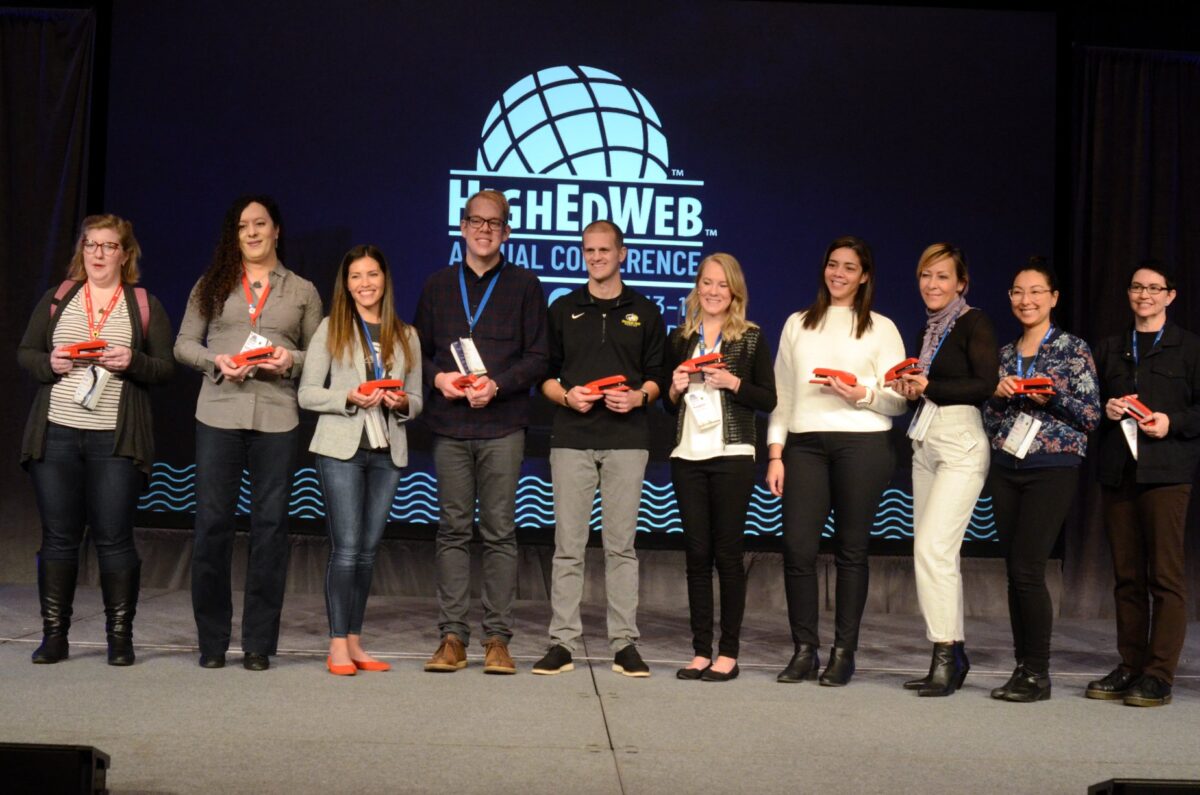Conference Speaking Tips from the Best of the Best
It’s more than a famous movie prop. It’s not just any old office supply. It’s an industry achievement.
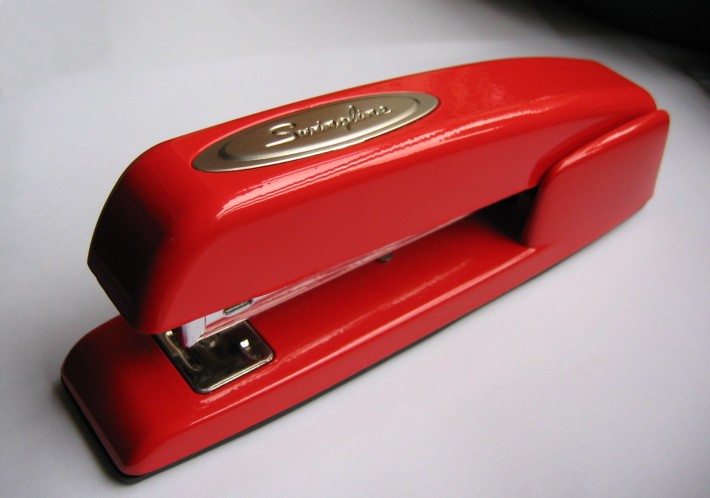
The Red Stapler Award is an attendee-driven honor recognizing the highest-rated session in each track, including poster sessions, at HighEdWeb’s annual conference. A Best of Conference winner is also selected from among these folks. (So fill out those conference surveys, friends! They matter!)
About a decade ago, Link did a virtual panel of sorts with a cohort of Red Stapler winners, and we’re rebooting that concept for the 2020s. Whether you are an experienced presenter or preparing for your first session, you’re sure to find inspiration in what these six savvy speakers have to share.
The Panelists
Before we dive into their nuggets of wisdom and practical tips, let’s meet our panelists.
Angela Cavaliere
Assistant Director of Digital Experience | Montgomery County Community College
Red Stapler Presentation:
Transforming the Student Portal Experience – 2022, Little Rock
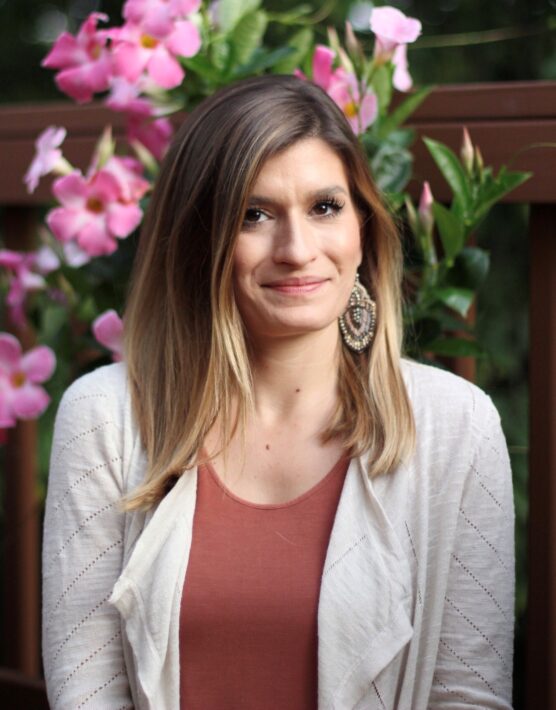
Angela Cavaliere started at Montgomery County Community College (Montco) in Pennsylvania eight years ago, first as the website administrator and then manager of digital usability. Today, in her present role, she oversees the college website and portal. Ever-focused on the student experience, Angela has been able to create a precedence of considering student feedback in decisions across the institution. Also an adjunct professor at Montco, she teaches courses in UX and UI. Outside of work, she enjoys baking, being creative, and spending time with her son.
Kristin Gasser
Web Developer | Arizona State University
Red Stapler Presentation:
A Web Team of One: Stop the Chaos and Set Up Your Game Plan – 2021, Online
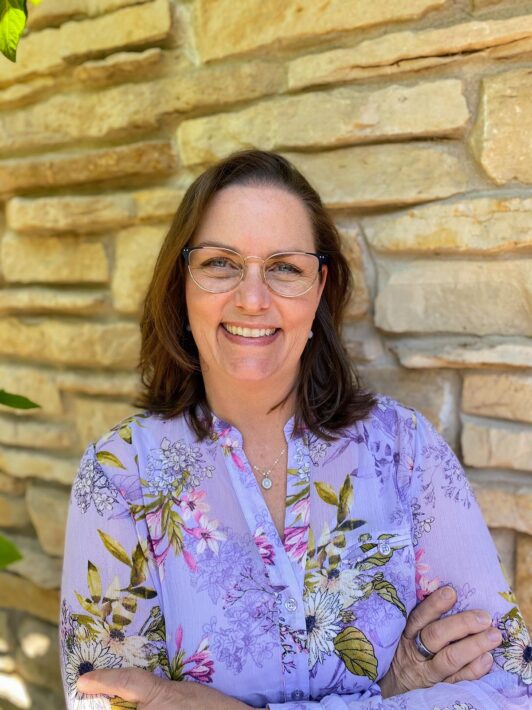
Kristin Gasser is a web content/UX developer who also wears a few other web hats. Working 100% remotely from Wisconsin, Gasser is part of a small web team that maintains hundreds of engineering websites at Arizona State University. She’s had a few stints as a “team of one” in her 23-year web career and is always striving to streamline and improve her workflows. Outside of websites and her family, Gasser enjoys audiobooks, cooking, knitting, hiking and walking her dog, Pippin.
Day Kibilds
Strategy Director | Ologie
Red Stapler Presentations The Art & Science of Collaboration – 2017, Hartford [also best of conference] (Day also earned a coveted Swingline for Get. Stuff. Done. – 2019, Milwaukee and “Get. (More.) Stuff. Done.” – Little Rock, 2022.)
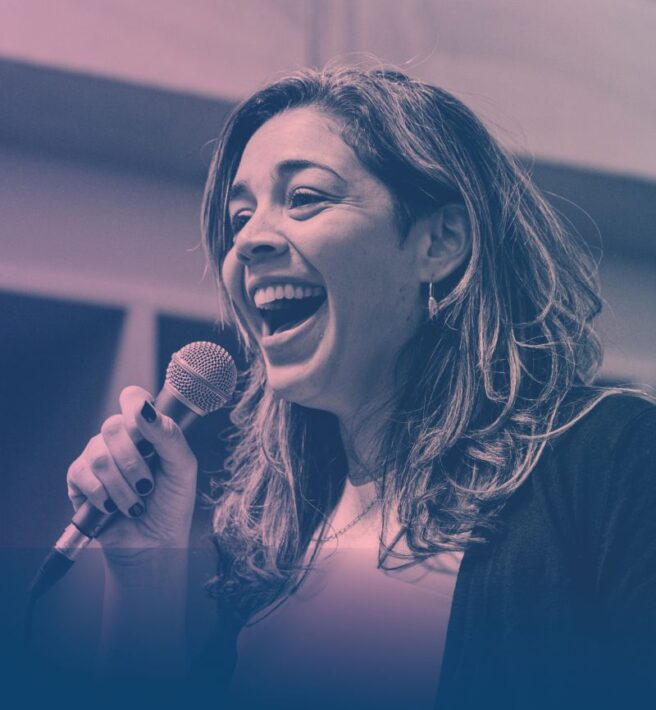
Day is strategy director at Ologie, focusing on branding, enrollment and marketing strategy for educational institutions. Prior to Ologie, she spent 12 years in higher education, leading enrollment and digital innovation work at Penn State, Cornell, and Western University (Canada). She regularly speaks about enrollment marketing, email strategy, productivity, and stakeholder management at global conferences such as CASE, HighedWeb, Confab, PSE Web and ContentEd. As a lifelong immigrant who has lived in six different countries, equity and diversity are really important to her. She sees content as a tool for equity, and part of her motivation to work in higher ed is to help students access the educational institutions they deserve to be a part of.
Luis Merino
Director, Digital Experience | Dallas College
Red Stapler Presentation: Empathy and Design Thinking: How Becoming Student-Focused Improved UX, Busted Silos & Built Bridges – 2020, Online
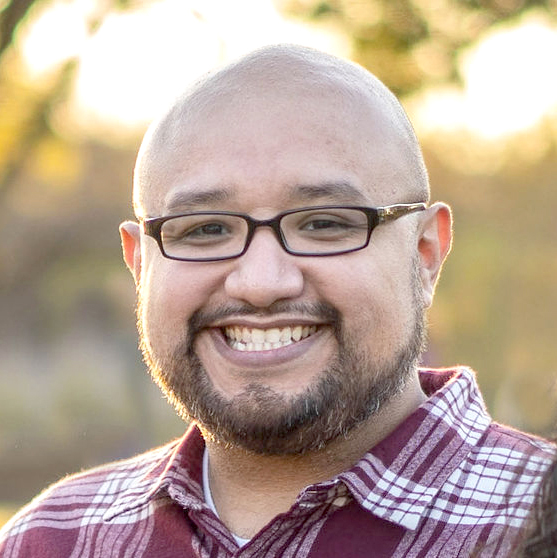
Throughout Luis Merino’s 20+ years as a professional and educator in graphic, web, user interface, and user experience design, he has learned the power of visual communication and storytelling. He joined the team at Dallas College (of which he is a product) in 2015, where he strives every day to put the student at the center of his work of crafting digital experiences. He and his wife, Natalia, are the proud parents of three beautiful girls. Of note, Luis won his Red Stapler Award at HighEdWeb’s first online annual conference.
Joyce Peralta
Manager, Digital Communications | McGill University
Red Stapler Presentation: Building a Community of Practice for Digital Standards Compliance (It’s More Fun Than You Think!) – 2022, Little Rock (also named best of conference)
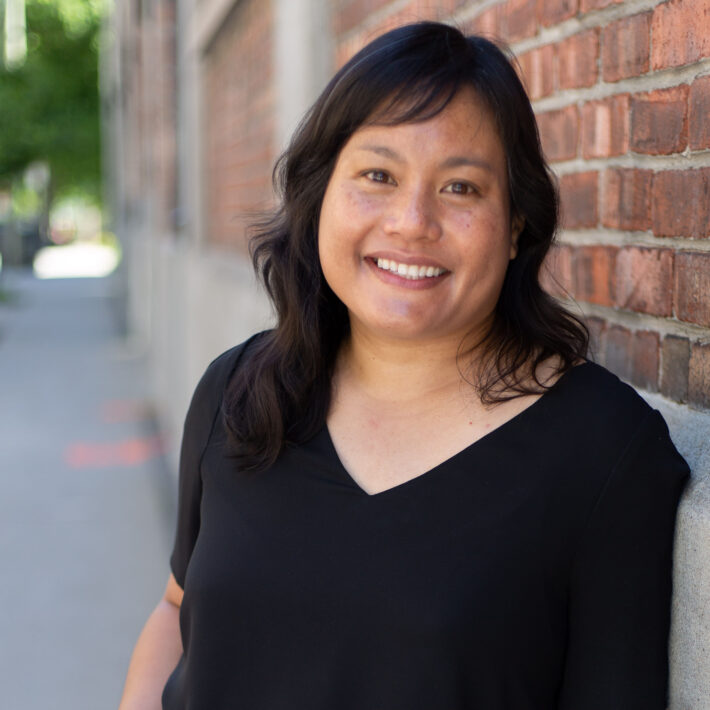
Joyce has been building websites and digital communities for 20 years, including 15 years’ experience in higher education. Since 2018, she has worked at McGill University, holding positions in Communications and External Relations and IT Services. Previously, Joyce held roles such as university web coordinator at the University of Victoria; senior web designer at Western University; and web developer at King’s University College. Joyce has presented at conferences across North America, including Confoo, DrupalCon, HighEdWeb and #PSEWEB, about web standards, governance, and user experience.
Joel C. Vertin
Executive Director of Digital Marketing | Michigan Technological University
Red Stapler Presentation: Be the MVP of Managers – 2019, Milwaukee (also named Best of Conference)
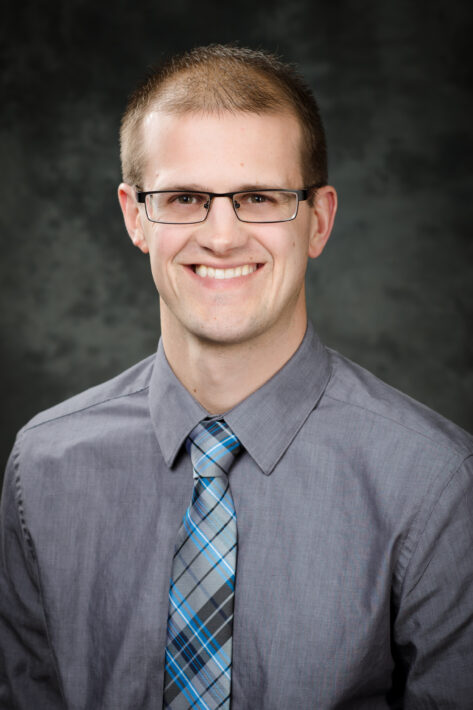
A Yooper, Joel C. Vertin has worked at Michigan Tech for nearly 20 years—first as a web student worker in the marketing department and progressing to web specialist, manager, director, and now executive director, where he oversees digital advertising, search engine optimization, web marketing, and data reporting. Joel discovered the HighEdWeb community in 2015. He has presented at the annual conference several times and currently serves as program co-chair for the Leadership Academy. Anyone is welcome to connect with Joel on the HighEdWeb Slack channel or through LinkedIn.
The Questions
We asked our Red Stapler winners a few questions, and we share their input here, round-robin style. Here’s what they had to say.
Give us your best tip (or two) for presenters of any skill level on making a presentation Red-Stapler-worthy.
ANGELA: I think my biggest piece of advice is to include tangible successes and real examples in your presentation. Attendees love to hear about the process, but providing information that demonstrates the return on investment and successes is crucial to pull it all together. Also, another thing is being candid and honest. After my Red-Stapler winning presentation, some of the feedback I received was that attendees appreciated me sharing the mistakes I made, along with the things that didn’t work. That is the reality when implementing large projects. There is definitely trial and error and it would be unfair to the attendees to not highlight these along with the successes.
DAY:
- Plan your transitions. The biggest difference between a good presentation and a great presentation is not the content on the slides; it’s the content between the slides. Plan what you’ll say to transition from one slide to the next.
- Show them how. The best presentations don’t just tell you what you should do, but exactly how. Everyone should be able to walk out of that room knowing how to implement what you just taught them.
- Be yourself. I’ve never been a big fan of formal presentation training because along with every “hmm” and “uh”, they also take away the parts of your speech that make you interesting and human. Be yourself and know your stuff, the delivery is not as important.
JOEL: Remember that you are awesome at the topic that you’re presenting. Have confidence. Blend being informative (your attendees want to have takeaways to implement in their own workspace) with telling your story (share authentic, human experiences to keep your audience interested and engaged).
JOYCE: Believe in your message and help your audience understand why they should believe in it too. Why is it important? What problems can it solve? What difference can it make in their projects, their work in general and possibly even the overall quality of their lives? Also, the number one bit of advice I’d have to share (though I realize I’m mentioning it second) is to practice. A LOT.
KRISTIN: My first tip is to put self-doubt aside. If you experienced something in your job, someone else at the conference will have experienced it, too. You are entering a world of kind, like-minded peers — enjoy the embrace! Secondly, choose a topic/story/problem you have experienced, and include how you solved it. Be specific, and if you can, provide action items people can take away and implement immediately.
Lastly, include humor. Laughing will allow you and your audience to relax and have more fun!
LUIS: I’ve found that the strongest presentations understand and employ the art of storytelling. And I am not talking about the inclusion of relevant stories from the presenter’s life or work—which are great! Include those. But I am referring to the arc of how stories, of all kinds, are built and structured with a beginning, middle, and ending. Take your audience through a journey!
- Beginning: Introduce your key players and set up their environment. Give relevant context and set up the central conflict to be resolved at the story’s end.
- Middle: What are the different beats of the story that create rising action as your key players seek to resolve the conflict. What additional challenges pop up?
- Ending: How do your players finally seek to overcome the conflict? What were the outcomes? What was learned? How did the players grow or progress over the arc of the story?
Bonus tip: Imbue your presentation with life and personality through any one or two of these: language, structure, tone, humor, color, or visuals. It does not have to be a fully themed presentation but put some of yourself into it.
“Put self-doubt aside.”
What is your best advice to a newbie presenter?
ANGELA: Just throw your hat in the ring and give it a shot! I started presenting eight years ago, and the first time I did I felt like I was having a heart attack. Practice helps so much, and now presenting comes so much easier to me. You gain confidence the more that you do it. Also, an important thing to keep in mind is that the attendees of your presentation want to see you succeed. They are there to hear about all of your great work, so you should feel confident knowing that!
DAY: Practice a lot. Practice enough to not need notes. Practice so much that everything you want to say becomes solid knowledge so you could talk about it without sounding like a script. I write down everything I want to say like a script. Then synthesize it into bullets. Then do 2-3 full-length runs of my talk in the two days leading up to my presentation.
JOEL: Put in the work. If you have never assembled a killer slide deck before, it is going to take time. Start the creative process early so you can build and adjust. Remember to rehearse several times to understand your timing and the points where you may tend to stumble. Practice makes better. Through all, be authentic — no one wants a robotic-like presentation.
JOYCE: The same best advice I received as a newbie presenter — be open. Make eye contact, uncross your arms, show your palms, and undo your top [shirt] button. I was told this makes people more receptive to your message and helps your audience relax, and I really believe that’s true. As a side benefit, it might help you relax, too.
KRISTIN: Try not to procrastinate in preparing your talk/slides, and practice out loud as much as you can. Go in your garage, outside, in a closet — wherever you need to go to be alone and go through your slides in peace. Just do it over and over until it feels like second nature. Hearing yourself say the words out loud gives you a feel for awkward spots that you can improve.
LUIS: This has been said before and will continue to be said: practice, practice, practice. There are some folks who are naturally able to “wing” public speaking and do it beautifully. I am not. I need practice! Here are a few things I have done to really allow the rhythm, transitions, and impactful points sink in:
- On my own, I have recorded myself over a webcam practicing the presentation. This helps you not only practice, it gives you the bonus of watching yourself and identifying parts to adjust. I’ve also recorded audio-only and listened to it several times while doing other things in the days leading up to the presentation.
- With coworkers, I have reserved a conference room for an hour on a slow Friday and invited them in to preview my presentation. This is great practice, and they can provide any feedback or suggestions.
“Believe in your message and help your audience understand why they should believe in it too.”
Do you have any presentation pet peeves?
ANGELA: I think for me the biggest pet peeve would be when the title of the presentation doesn’t match the content being presented. I have definitely sat in sessions and realized within the first five minutes that the content didn’t pertain to me, which is frustrating.
DAY: Yes. When there is more than one person presenting, I really don’t like the “and now I will pass it on to my colleague to talk to you about…” Plan your transitions so you flow smoothly from one speaker to the next as part of the narrative.
JOEL: Some presenters like to keep their slides very brief with only a few words. While that can lead to awesome storytelling as your audience must pay attention to you, I try to remember that the audience also wants takeaways to bring back to their workspace. I include key information and reference links on my slides for those who want to download and reference those slides later on. If a slide is getting too long, break it up. You can move through them efficiently.
JOYCE: Presenters who don’t bring their own clicker. (Sorry, I really don’t want to lend you mine because I need it, and now I feel guilty for turning you down.)
KRISTIN: I hate when my tech doesn’t work the way I like it to, but that happens. Don’t put too much weight on a cool thing that is supposed to work in the moment, such as a recorded sound bite or a YouTube recording. Assume you’ll have issues and figure out a work-around in advance if you can, or an alternative. If you are using online slides, such as Google Slides, always have a downloaded version you can use in case the internet is slow in your track room.
LUIS: Here are some of my biggest presentation pet peeves:
- Forced interaction (that is also cliched). When presenters insist that the first “good morning,” you parroted back to them was not good enough, so they have you do it again.
- Too much text or visual clutter in one slide. If you are trying to illustrate a complex process with lots of pieces, I would recommend introducing pieces of it at a time so as not to overwhelm the audience.
- Presentations that lack focus or structure. Structure helps the audience know what to expect about where the presentation is going.
Reading directly from slides. Need I say more?
“If a slide is getting too long, break it up. “
What is the one thing you do in the final hours/minutes before your presentation — any special ways you get ready?
ANGELA: I review my slides one last time before going into the room. Take some deep breaths, shake it out a bit, and remind myself that I am the content expert!
DAY: I like to be alone before a presentation. I stop thinking about the content and just try to be in the moment. I get nervous every time, so I find walking up and down the stairs helps me elevate my heart rate and calm it back down.
JOEL: I like to do a faster run-through of my slides in the morning — especially focusing on the parts of the presentation that tended to run too long or otherwise tripped me up during my previous practice runs. I confirm in my mind what my plan is to get through these parts smoothly.
After that, I try to go about my day normally and don’t think about the presentation too much. When it is ‘go time’, I have the confidence that I put in the necessary work ahead of time and that the presentation will go wonderfully, so I’m excited to showcase my expertise to benefit others.
JOYCE: I go through my presentation in my head while I’m getting ready in the morning, usually in the shower. I find this is a good way for me to reassure myself that I know the material – that I’m feeling comfortable and prepared.
KRISTIN: I got to my hotel room and practice my talk out loud until I get bored. When I’m bored (i.e., no longer nervous), I’m ready!
LUIS: I always check out the presentation space as soon as I can. It helps ground me and provides me visual context for how the parts of the presentation will play out in my head leading up to the presentation. In the hour before, I usually retreat to my hotel room or a private place to go over the weaker parts of the presentation. This usually includes nervous pacing back and forth while talking to myself. Then I like to get to the presentation room about 30 minutes before just to make sure everything is good to roll.
“Take your audience through a journey!”
Bonus Question
One of the best things about our welcoming community is the holistic mentorship that happens. For example, each year, you’ll see many first-time presenters taking the stage, often encouraged or inspired by speakers they’ve seen at HighEdWeb or elsewhere. So I tossed out a bonus question to our panelists.
Any past HighEdWeb presenters (or speakers from outside our industry) who have inspired you, and why?
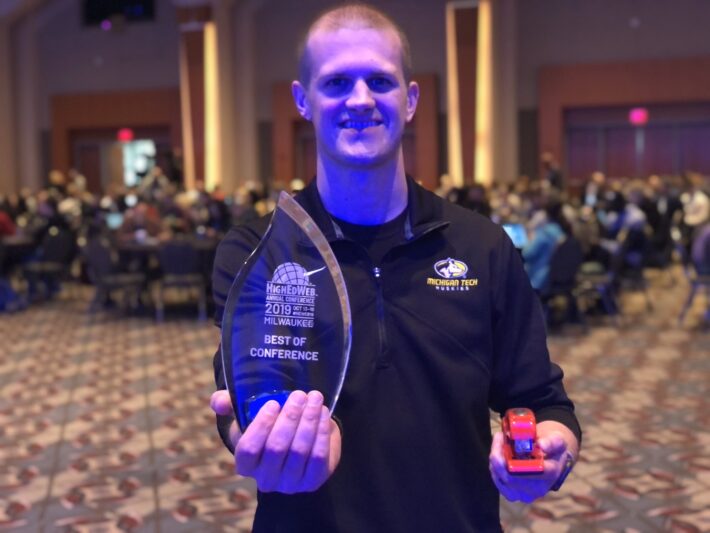
JOEL: Catherine Scholz and Sven Aas. They both have technical backgrounds and are very savvy in bringing interpersonal and team-building techniques into their managerial processes. Their philosophies match up with my own.
Jeff Stevens, Larry Falck, and Paul Gilzow have shown me how to have fun and be less serious while still educating and providing actions for the audience to take back to their workspace. Nikki Massaro Kauffman and Alaina Wiens always have awesomely detailed slide decks that I have brought back to my office to use nuggets with my team.
Few of these speakers actually know me, but their approach, style, and charisma have influenced my own presentation philosophy and flair.
JOYCE: I love a good story, so I’m going to say, Shannon Cason’s keynote at HighEdWeb 2021 and Jack Saddleback’s keynote at #PSEWeb 2019. I also saw Safiya Noble of the UCLA Center for Critical Internet Inquiry deliver their Algorithms of Oppression presentation as the keynote at DrupalCon Pittsburgh this year — so eye-opening! And I have to mention Romeo Dallaire, whom I saw speak at Western University a number of years back. His talk changed my life view.
KRISTIN: There have been so many speakers at past conferences that have inspired me. I learned a lot at my first HighEdWeb conference from Georgy Cohen (OHO Interactive). She really lit a fire under me to start the very hard job of applying content strategy to websites where none had previously existed. I have also been inspired by Day Kibilds of “Get. Stuff. Done.” fame, for her no-nonsense approach to productivity and smart work. Brian Piper is a Google Analytics walking encyclopedia and I always leave his talks with a million take-aways. There are so many more — but I’ll stop there!
With the 2023 annual conference approaching soon, we wish all of our upcoming presenters the best of luck. If you’re interested in speaking at future annual conferences —as well as our summits, academies, and regional events — stay on the lookout for calls for proposals from HighEdWeb’s newsletter and social channels.

